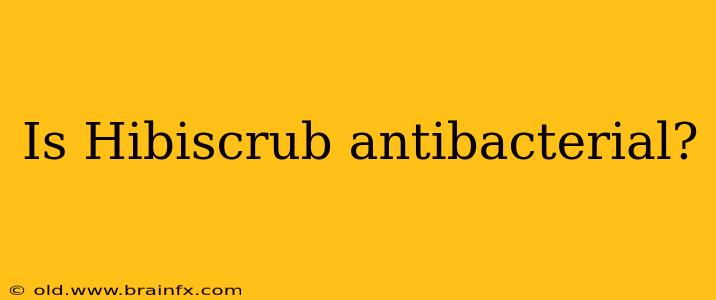Hibiscrub, a popular antiseptic solution, is frequently used for skin disinfection before procedures and to treat minor wounds. But the question remains: is Hibiscrub antibacterial? The short answer is yes, but understanding its specific properties and limitations is crucial.
Hibiscrub's Active Ingredient: Chlorhexidine Gluconate
The key to Hibiscrub's effectiveness lies in its active ingredient, chlorhexidine gluconate. This broad-spectrum antiseptic possesses powerful antibacterial, antifungal, and antiviral properties. It works by disrupting the cell membranes of microorganisms, leading to their inactivation and death. This mechanism makes it effective against a wide range of bacteria, including Gram-positive and Gram-negative organisms.
Broad-Spectrum Antimicrobial Action
Hibiscrub's broad-spectrum action is what makes it so useful in various medical and personal care settings. It effectively targets a variety of pathogens, making it a valuable tool for preventing infections. This includes:
- Gram-positive bacteria: Such as Staphylococcus aureus (including MRSA strains, though resistance can develop) and Streptococcus pyogenes.
- Gram-negative bacteria: Such as Escherichia coli and Pseudomonas aeruginosa.
- Fungi: Including Candida albicans.
- Viruses: While less effective than against bacteria and fungi, it still shows some activity against enveloped viruses.
Beyond Antibacterial: Understanding its Uses
While its antibacterial properties are central to its function, it's important to note that Hibiscrub is not a cure-all. It's primarily used for:
- Pre-operative skin disinfection: Preparing the skin before surgery or other invasive procedures helps minimize the risk of infection.
- Treatment of minor wounds: It can be applied to minor cuts, grazes, and burns to help prevent infection.
- Hygiene in healthcare settings: Used frequently in hospitals and other healthcare facilities for hand hygiene and disinfection of surfaces.
Limitations of Hibiscrub
It's crucial to understand Hibiscrub's limitations:
- Not effective against all microorganisms: While broad-spectrum, it isn't effective against all types of bacteria, fungi, or viruses. Spores, for example, are generally resistant.
- Potential for resistance: Prolonged or inappropriate use can lead to the development of microbial resistance.
- Not for internal use: Hibiscrub is for external use only and should never be ingested.
- Possible side effects: Some individuals may experience skin irritation or allergic reactions.
Conclusion: Hibiscrub – A Powerful Antibacterial Agent
In conclusion, Hibiscrub is indeed antibacterial, thanks to its active ingredient, chlorhexidine gluconate. Its broad-spectrum antimicrobial properties make it a valuable tool in preventing infections in various settings. However, it's essential to remember its limitations and use it appropriately to maximize its benefits and minimize potential risks. Always follow the instructions provided on the packaging and consult a healthcare professional if you have any concerns or questions about its use.

